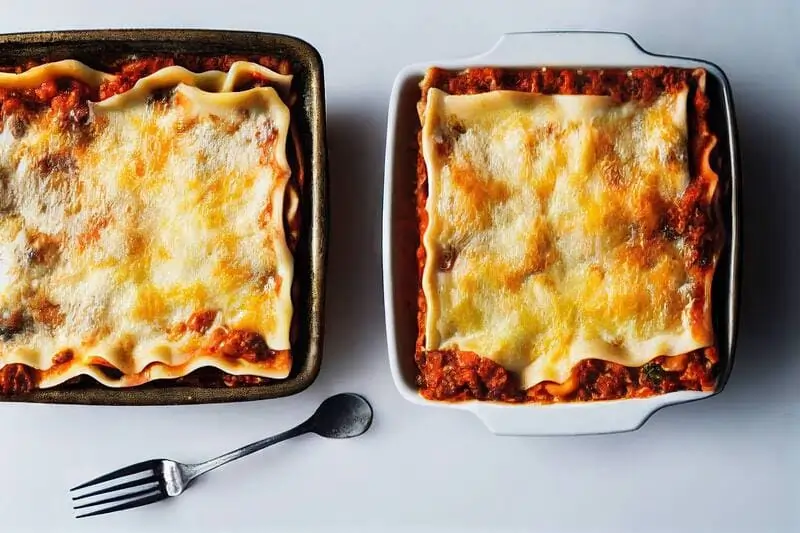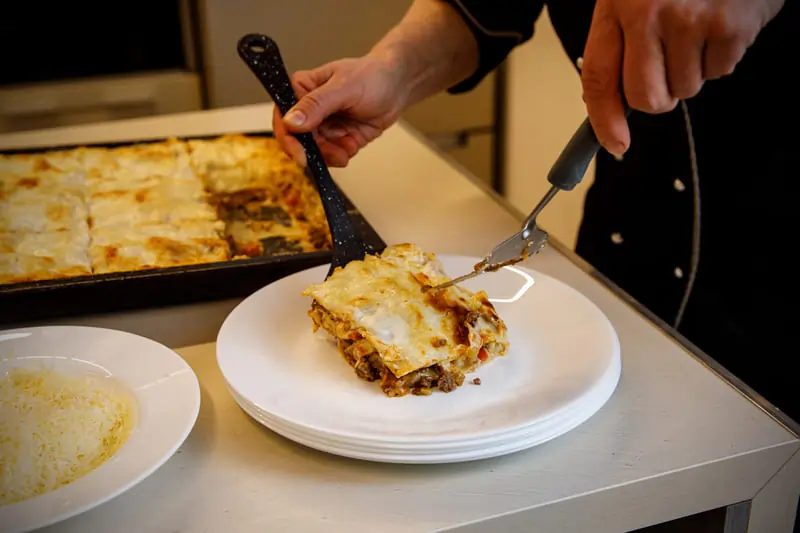fLasagna is a timeless classic that’s loved worldwide. While its flavor depends on the quality of ingredients, its structure and cooking success rely heavily on assembling the correct layers. From the base to the finishing touch, how you layer lasagna affects its taste, texture, and presentation. Whether you’re a novice or an experienced cook, mastering the art of layering is essential for a perfect dish.
Why Does the Order of Lasagna Layers Matter?
Layering lasagna in the right order ensures each bite delivers a balance of sauce, pasta, and cheese. The sequence also impacts cooking time, moisture distribution, and structural integrity. Starting with the right base, maintaining consistent layers, and ending with a finishing touch is the foundation of success. For a detailed overview of the perfect layering technique, check out this step-by-step guide to layering lasagna.
Improper layering can lead to unevenly cooked lasagna or, worse, a soggy or dry mess. To avoid these pitfalls and create an ideal dish every time, refer to this comprehensive guide to assembling lasagna for the best results. If you’re exploring new ways to prepare lasagna, try this classic Barilla lasagna recipe for inspiration.
The Correct Layers for Lasagna
Crafting the perfect lasagna involves following the correct layering order to achieve a dish that is evenly cooked, flavorful, and visually appealing. Here’s a more detailed breakdown of each layer and its importance, along with tips to enhance your lasagna:
1. First Layer: Sauce
The base layer of sauce is essential for both flavor and functionality. Starting with a thin, even layer of marinara, béchamel, or your preferred sauce ensures the noodles won’t stick to the bottom of the baking dish. This layer also provides moisture that helps cook the noodles evenly, particularly when using oven-ready sheets. Spread the sauce generously across the pan, ensuring full coverage for a flavorful foundation.
2. Second Layer: Noodles
Once the sauce is in place, lay down the lasagna noodles. Slightly overlapping the noodles prevents gaps, creating a sturdy base for the subsequent layers. For oven-ready noodles, it’s important to ensure the sauce beneath them is sufficiently moist, as this liquid will soften the pasta during baking. If you’re using boiled noodles, pat them dry before layering to avoid excess water seeping into the lasagna.
3. Third Layer: Cheese Mixture
The next step is spreading the cheese mixture. Traditional lasagna recipes use a creamy blend of ricotta cheese, eggs, and seasonings such as salt, pepper, and nutmeg. Spread the mixture evenly across the noodles to provide a consistent texture and flavor. If you prefer a lighter alternative, a smooth béchamel sauce can replace ricotta, offering a creamy yet subtle layer.
4. Fourth Layer: Fillings
Add your choice of fillings, such as seasoned ground meat, roasted vegetables, or even seafood for a unique twist. Be sure to distribute the fillings evenly to ensure every bite offers a balanced mix of ingredients. Avoid overloading this layer, as too much filling can make the lasagna difficult to slice and serve. For added flavor, sprinkle shredded mozzarella or parmesan on top of the fillings.
5. Repeat the Layers
Continue layering in the order of sauce, noodles, cheese, and fillings, repeating the sequence 2–3 more times depending on the depth of your dish. Each repetition enhances the flavor and structure of the lasagna. End the layering with a final sheet of noodles, generously topped with sauce to ensure the top layer of pasta doesn’t dry out. Finish with a layer of shredded cheese, such as mozzarella or parmesan, to create a golden, bubbling crust during baking.
Additional Tips for Perfect Lasagna Layers
- Consistent Thickness: Keep each layer uniform in thickness to ensure even cooking and balanced flavor throughout.
- Choosing Fillings: Experiment with different fillings like spinach, mushrooms, or sausage to create unique variations of your lasagna. For vegetarian options, roasted zucchini or eggplant are excellent choices.
- Finishing Touches: Sprinkle fresh herbs, like basil or parsley, over the top layer of cheese before baking to add a touch of freshness and aroma to your dish.
For more inspiration and guidance on creating the ultimate lasagna, explore recipe collections on culinary websites or consult expert tips on layering techniques. These resources can provide creative ideas for experimenting with flavors and ensuring your lasagna is a crowd-pleasing masterpiece.
Popular Variations of Lasagna Layers

1. Vegetable Substitutes:
For those looking to reduce carbs or make a gluten-free lasagna, replacing traditional noodles with vegetable slices is an excellent option. Thinly sliced zucchini, eggplant, or even sweet potatoes can serve as substitutes for pasta sheets. These alternatives not only provide a lighter texture but also add natural sweetness and nutritional benefits to the dish. To prevent excess moisture, lightly salt the vegetable slices and let them rest before patting them dry.
2. Alternative Cheeses:
Cheese plays a central role in lasagna, and switching up the types of cheese used can drastically change its flavor profile. For a richer and creamier texture, mascarpone cheese is an indulgent choice that melts beautifully between layers. If you prefer a sharper and more robust flavor, consider adding grated parmesan or pecorino romano. Combining multiple cheeses, for instance, mozzarella, gouda, and asiago, can create a complex flavor blend that elevates the dish to gourmet levels.
3. Creative Fillings:
Expand your filling options beyond traditional ground meat. Incorporating spinach, mushrooms, or roasted bell peppers introduces earthy and savory notes to the dish. For plant-based variations, use crumbled tofu, lentils, or plant-based proteins to mimic the texture and flavor of meat. If you’re adventurous, adding artichokes, sun-dried tomatoes, or caramelized onions can create a lasagna with a unique, Mediterranean twist.
Additional Tips for Layer Variations
- Balance Moisture: When using vegetables or alternative cheeses, adjust the sauce consistency to maintain the right moisture level throughout the dish. Too much liquid can lead to a soggy lasagna, while too little may leave the layers dry.
- Flavor Enhancers: Incorporate fresh herbs like basil, oregano, or thyme into your fillings or cheese mixtures to deepen the flavor. A sprinkle of nutmeg in béchamel or ricotta adds warmth and complexity.
- Layering Order: Regardless of the variations, maintaining the standard layering order of sauce, substitutes (or noodles), fillings, and cheese helps to ensure the dish cooks evenly and retains its structure.
For more ideas on how to balance flavors and create perfectly layered dishes, explore guides on advanced layering techniques, such as building complex flavors in lasagna. These resources can provide inspiration for crafting lasagna that not only tastes amazing but also impresses with its creativity and balance.
Expert Tips for Layering Lasagna

1. Rest Before Serving:
One of the most overlooked but crucial steps in lasagna preparation is allowing it to rest after baking. Letting the dish sit for 10–15 minutes allows the layers to settle and firm up, making slicing much easier. This resting period also helps the flavors meld together, giving each bite a more cohesive and balanced taste. Cutting into the lasagna too soon can result in messy layers and uneven servings.
2. Cover and Uncover During Baking:
The baking process greatly influences the texture and moisture of your lasagna. Cover the dish with aluminum foil during the first two-thirds of the baking time to trap steam and retain moisture, ensuring the noodles cook thoroughly and the layers meld seamlessly. For the last 15–20 minutes, uncover the lasagna to let the top layer brown and develop a crispy, golden crust. This dual approach strikes the perfect balance between tenderness and texture.
For detailed guidance on managing moisture during baking, explore this comprehensive guide on covered versus uncovered lasagna baking. It provides insights into achieving the ideal lasagna texture while preventing dryness or sogginess.
3. Even Spreading:
Achieving consistent layers is key to a well-cooked lasagna. Use a spatula or the back of a spoon to spread sauces, cheese mixtures, and fillings evenly across each layer. This ensures every bite has a balanced combination of flavors and textures. Uneven spreading can lead to overcooked edges or undercooked centers, which can affect the overall quality of the dish.
Additional Tips for Perfect Lasagna Layers
- Moisture Control: Ensure the sauce is neither too thick nor too watery. A properly balanced sauce prevents noodles from drying out or becoming soggy while maintaining the right texture for the dish.
- Layer Thickness: Avoid overloading any single layer with too much sauce, cheese, or filling. Keeping the layers uniform ensures even cooking and a clean, structured appearance when served.
- Finishing Touch: For a professional finish, sprinkle fresh herbs like basil or parsley on top after baking. A light drizzle of olive oil over the browned cheese can also enhance flavor and give your lasagna a polished look.
By incorporating these expert tips into your lasagna-making routine, you can achieve a dish that is both flavorful and visually stunning. For more advice on baking techniques and perfecting your favorite recipes, consult trusted cooking resources or guides that delve into the nuances of layered dishes. These insights will help you take your lasagna to the next level, impressing both family and guests alike.
Common Mistakes and How to Avoid Them
1. Uneven Layers:
One of the most frequent errors in lasagna preparation is uneven layering. Layers that are inconsistent in thickness or improperly distributed can lead to instability in the structure, causing the lasagna to collapse when sliced. Uneven layers can also result in some areas being overcooked while others remain underdone. To avoid this, carefully spread each layer of sauce, cheese, and filling using a spatula, ensuring even distribution across the entire dish. A balanced approach not only enhances the cooking process but also creates a visually appealing final product.
2. Too Much Cheese:
While cheese is a key component of lasagna, using excessive amounts can cause the dish to become overly heavy and soggy. Too much cheese prevents proper evaporation of moisture during baking, leading to a lasagna that lacks structure and balance. To prevent this, stick to recommended measurements and avoid overloading layers with cheese. Incorporating a blend of cheeses, such as mozzarella, ricotta, and parmesan, in appropriate quantities can add depth of flavor without compromising texture.
3. Skipping Sauce at the Base:
Starting with noodles instead of sauce at the base of the dish is a common mistake. Without a sauce layer beneath, the noodles can stick to the bottom of the pan, making serving difficult and potentially ruining the presentation. Always begin with a generous layer of sauce to create a non-stick barrier and provide the necessary moisture to cook the noodles evenly.
Troubleshooting Tips
Adjust Sauce Consistency:
If your sauce is too thick, it may not provide enough moisture for the noodles to cook properly, resulting in dry lasagna. Conversely, a watery sauce can lead to soggy layers. Aim for a balanced consistency by adjusting the sauce with a splash of water or broth if it’s too thick or simmering it longer to reduce excess liquid. For more tips, explore this guide on achieving the perfect sauce consistency.
Ensure Even Layers:
To prevent dry or soggy spots, focus on distributing each ingredient evenly. Spread fillings and sauces uniformly across the noodles, ensuring full coverage without overloading any single layer. This practice promotes even cooking and ensures that every bite delivers the same delicious flavors.
Prevent Overcooked Edges:
If the edges of your lasagna begin to brown too quickly or overcook, cover them with aluminum foil during the baking process. Check the dish periodically and add foil as needed to shield the edges while allowing the center to cook thoroughly. This technique also works well for lasagna baked at higher temperatures.
Additional Suggestions for a Perfect Lasagna
- Resting Time: Let the lasagna rest for 10–15 minutes after baking to allow the layers to set, making it easier to cut and serve.
- Test Cooking Time: Check the lasagna periodically to avoid overbaking. The ideal texture should be tender noodles with firm yet creamy layers.
- Herb Finishes: Add fresh basil, parsley, or a sprinkle of oregano on top after baking for added flavor and an appealing garnish.
By addressing these common mistakes and applying practical solutions, you can elevate your lasagna to a restaurant-quality dish. For more detailed guidance and techniques, explore trusted culinary resources and step-by-step recipes that provide expert insights into perfecting every layer.
FAQs
1. What’s the first layer of lasagna?
The first layer should always be sauce to prevent sticking and add moisture. For more details on building a strong base for your lasagna, read this step-by-step guide to layering lasagna.
2. Do you have to cook lasagna noodles first?
Pre-cooked noodles don’t need boiling, but traditional noodles require a quick boil before layering. Learn how to adapt your recipe using either type of noodle with these lasagna preparation tips.
3. How many layers should lasagna have?
Three to four full cycles of layers, ending with sauce and cheese, is ideal. If you’re experimenting with creative variations, check out this zucchini lasagna recipe for inspiration.
4. Can you use vegetables instead of noodles?
Yes, substitutes like zucchini or eggplant slices work well in gluten-free or low-carb versions. For more ideas on layering with vegetables, explore this guide on creating healthy layered dishes.
5. What’s the best cheese for lasagna?
Ricotta, mozzarella, and parmesan are traditional choices, but mascarpone or béchamel adds creaminess. To learn how to make a perfect béchamel sauce, check this classic recipe guide.

